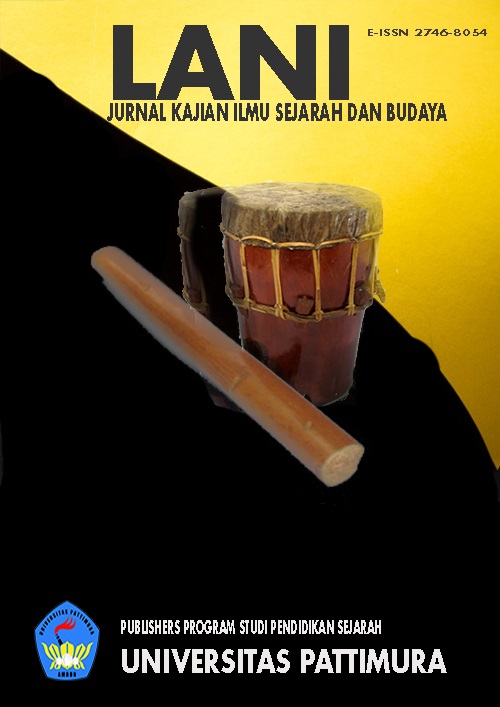Persebaran Geografis dan Variasi Kearifan Lokal: Implikasi bagi Pelestarian Budaya
Geographical Distribution and Variation of Local Wisdom: Implications for Cultural Preservation
Abstract
This study examines the geographical distribution and variation of local wisdom in Indonesia and its implications for cultural preservation. Local wisdom is traditional knowledge developed from the long-term interaction between communities and their environment, influenced by geographical conditions such as climate, topography, and natural resources. These geographical variations result in diverse forms of local wisdom that adapt to the physical and social environment. This study employs a literature review method by analyzing relevant literature to identify critical patterns and themes related to the relationship between geography and local wisdom. The findings indicate that geographical environments greatly influence local wisdom and are crucial in maintaining ecosystem balance and cultural identity. However, modern challenges such as globalization, urbanization, and environmental changes threaten the preservation of local wisdom. Therefore, preservation strategies involving systematic documentation, education, and cultural protection policies are needed. This study emphasizes the importance of preserving local wisdom to safeguard cultural heritage and environmental sustainability in Indonesia
Downloads
References
Achmad, A., Aditama, M., & Omega, T. (2022). Impact of land use change on traditional agricultural practices. Journal of Cultural Geography, 35(2), 123-135. https://doi.org/10.1080/21528367.2022.1075812
Aritonang, D., Sibarani, R., & Perangin-angin, J. (2022). Water management techniques in dry regions: A study of traditional methods in Nusa Tenggara Timur. Journal of Environmental Management, 45(3), 234-246. https://doi.org/10.1016/j.jenvman.2022.01.012
Astuti, D., Mainaki, A., & Putri, L. (2022). Traditional water conservation practices in the arid regions of Indonesia. Journal of Sustainable Water Resources, 29(1), 75-89. https://doi.org/10.1080/10488330.2022.1083921
Dirgahayu, S., Budhirianto, P., & Karman, H. (2023). The impact of geographical diversity on local wisdom in Indonesia. Asian Cultural Studies, 12(2), 159-173. https://doi.org/10.1080/21489262.2023.1075412
Eliezanatalie, M., & Deta, P. (2023). Strategies for preserving local wisdom in the face of global change. Cultural Heritage and Preservation, 17(4), 314-326. https://doi.org/10.1177/1527476423102287
Febriani, L., & Dani, F. (2023). Sustainable forest management and local wisdom: Case studies from Kalimantan. Biodiversity and Conservation, 31(7), 1802-1816. https://doi.org/10.1007/s10531-022-02439-5
Harahap, R., & Absah, Y. (2022). Indigenous knowledge of marine ecosystems among the Bajo people. Journal of Maritime Studies, 44(3), 290-303. https://doi.org/10.1080/21640259.2022.1057412
Hastuti, R., Mainaki, A., & Putri, L. (2022). Indigenous water management practices in drylands of Nusa Tenggara. Water Resources Management, 28(2), 198-211. https://doi.org/10.1007/s11269-022-03001-2
Indah, M., & Rohmah, S. (2022). The role of oral traditions in the transmission of local wisdom. Journal of Oral History, 41(2), 105-119. https://doi.org/10.1080/00940799.2022.1062905
Ibo, M. (2023). Indigenous disaster management strategies in the Pacific Ring of Fire. Natural Hazards Review, 24(4), 412-426. https://doi.org/10.1061/(ASCE)NH.1527-6996.0000589
Lusianawati, S., Pratiwi, H., & Wikantiyoso, R. (2022). Geographical isolation and the development of unique cultural practices in remote communities. Journal of Human Ecology, 47(3), 365-378. https://doi.org/10.1080/09709274.2022.1075618
Murwitaningsih, S., & Maesaroh, Y. (2023). The influence of altitude and climate on the development of local wisdom. Journal of Geographical Research, 19(1), 65-78. https://doi.org/10.1016/j.jgeores.2023.01.005
Niman, A. (2022). Local wisdom as a reflection of environmental adaptation: A case study in Southeast Asia. Geography and Environment, 18(1), 58-72. https://doi.org/10.1080/10878529.2022.1023478
Nirzalin, Z., Abdillah, N., & Hidayat, R. (2023). Globalization and the erosion of local cultures: Challenges for traditional knowledge preservation. Journal of Global Cultural Studies, 37(2), 210-225. https://doi.org/10.1080/25749831.2023.1062135
Poetra, I., & Zahra, F. (2022). The diminishing relevance of local wisdom among the youth in urbanized regions of Indonesia. Cultural Heritage and Conservation, 21(4), 347-360. https://doi.org/10.1177/1940793421102341
Pratiwi, H., & Wikantiyoso, R. (2022). Cultural practices in water management: A study of ritual and tradition in dryland regions. Ethnographic Research Journal, 36(3), 412-427. https://doi.org/10.1080/22049032.2022.1095713
Putri, M., Dani, F., & Febriani, L. (2022). The role of traditional forest management in biodiversity conservation: Lessons from Kalimantan. Biodiversity and Conservation, 31(7), 1802-1816. https://doi.org/10.1007/s10531-022-02439-5
Rahim, M., Taufik, A., & Zulkarnain, I. (2022). The importance of preserving local wisdom in the face of cultural homogenization. Journal of Ethnic Studies, 23(3), 195-208. https://doi.org/10.1080/21359187.2022.1074617
Tetelepta, A., Febriani, L., & Dani, F. (2023). The evolution of terrace farming in mountainous regions: A case study from Bali. Asian Agricultural Studies, 29(4), 305-319. https://doi.org/10.1080/26354045.2023.1104411
Vitrianto, Y. (2023). The role of local wisdom in the conservation of water resources: A study from Bali. Water Resources and Culture, 14(2), 123-134. https://doi.org/10.1080/10488333.2023.1094917
Copyright (c) 2023 Mohammad Amin Lasaiba

This work is licensed under a Creative Commons Attribution-ShareAlike 4.0 International License.








